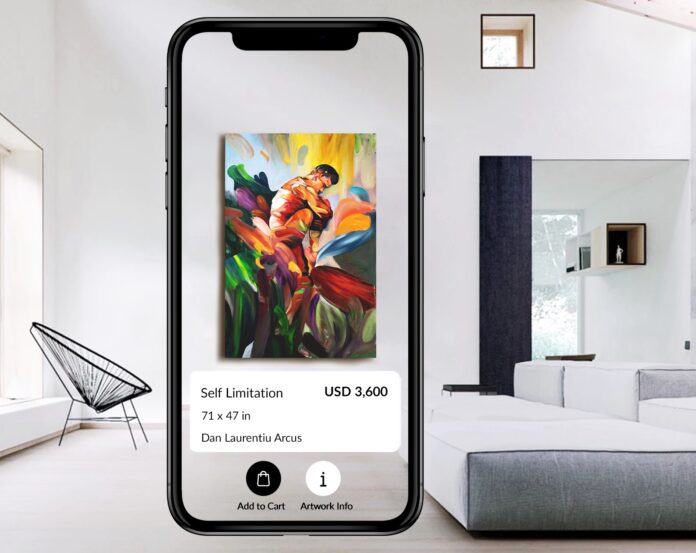RtistiQ, a mobile app and website art marketplace, is the first in Singapore and Southeast Asia to leverage technologies such as blockchain, non-fungible tokens (NFT) and near field communication (NFC) for art authentication. With artists from approximately 29 different countries across the globe on board, the online marketplace now houses approximately 2,500 art assets and US$8 million worth of merchandise value. The brand has been building a vibrant community of artists, collectors, art enthusiasts, soon galleries and art professionals.
Traditionally, artists would have physical representations of their artwork at on-site galleries. However, the global pandemic has pivoted the scene towards online representations where artists are increasingly looking for a trustworthy platform to showcase their artwork. RtistiQ is an artist-friendly marketplace that not only provides artists with an online platform for sales, but also addresses their concerns such as untrackable provenance, the absence or delayed royalties received, copyright infringement, and the lack of transparency in the primary art marketplace. As such, the number of artists onboarding RtistiQ has been doubling each month since April and has more than 200 artists on board currently.
Jothi Krishnan Menon, co-founder and CEO of RtistiQ said, “The goal of the platform is to create a complete end-to-end solution for our artists and their work. Using technologies that have been established and heavily utilised in other industries, like blockchain, augmented reality, and NFC, we are looking to reshape the art market. We want to give peace-of-mind to art buyers from around the world when it comes to authenticity, as well as provide artists from across the world the opportunity to reach a wider audience for their art.” Additionally, Rtistiq is expected to build up a portfolio of over 1500 artists onboard from more than 50 countries and 20,000 artworks by March 2022.
Providing another sales avenue for artists
A significant and recurring concern for artists across the globe is their inability to insure their financial future by benefiting from royalty rights schemes. Artists often could not benefit from the royalties as it is very difficult for the artists to track the changes in ownership of their artworks. Recently, the New York Times investigated a dispute between artists and the Artist Pension Trust, a company that promises to provide artists with financial security. However, more than 140 artists did not receive sales or payouts, and many of them were not even able to locate their artwork. This mishap is a common occurrence in the art industry, clearly highlighting the importance of ensuring tampering proof records. Additionally, provenance tracking provided by blockchain registration would prevent the sale of forged or stolen artworks.
RtistiQ uses an NFT-based tokenization to represent any form of artwork; this transparent attribution to the creator acts as a digital signature for authentication and provides provenance tracking. This is further aided by the unique blockchain account of each artist, which digitizes the Certificate of Authenticity (COA), thereby giving artists a better control over their artwork sales but also assuring collectors of the work’s authenticity. Additionally, using tamper-evident NFC stickers, artists can easily create a physical-digital link to their creation that can be scanned using an NFC-enabled mobile device.
According to Siberia-born and US-based artist, Aleks Rosenberg, the pandemic presented an opportunity for online galleries to be legitimized as well as democratize access for lesser-known artists to showcase their works. However, the multimedia artist said that based on his personal experience, the more established platforms already had a roster of thousands of artists and the ones who got preferential algorithm treatment were the ones who were already established. As he only had small successes in selling a few pieces, he sought opportunities elsewhere. He was first intrigued by RtistiQ’s use of blockchain to secure the authenticity of his artwork before deciding “to invest my time and energy into RtistiQ because of the personal outreach by my curator who took the time to help understand, organise and promote my work on the platform,” shared Rosenberg. This blend of tech-enabled features on the platform and the hands-on high-touch approach from its curators help to maximize the artist’s experience.
RtistiQ digitising the art purchase experience
RtistiQ takes pride in enhancing buyers’ experience by being one of the first art applications to integrate AR projection. Research by Hiscox revealed that the biggest concern of hesitant online buyers was not being able to know if their desired artwork was truly represented on-screen. The lack of ability to simulate and digitize the art purchasing experience amongst existing art marketplaces in Asia is a huge drawback for buyers. RtistiQ helps address these concerns by offering their users an immersive experience with the artworks.
The rapidly growing art market in Singapore and the rest of Asia, despite having many established art collectors, is still driven by first-time buyers and individuals looking to decorate their homes and office spaces. The integration of immersive art technology such as AR actualizes the artwork for potential buyers on the pretext of their own space. This enhances the digital art purchase experience by aiding potential buyers with visualizations of their desired artwork.
Author’s Bio– Aleks Rosenberg, born in Siberia and educated in the United States, is an award-winning American
multi-media artist and filmmaker who resides in the United States and has exhibited and sold his
works internationally.
Received From Press Release






